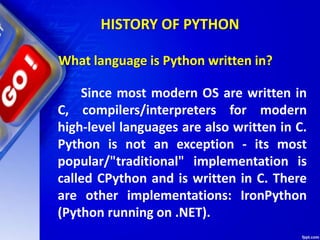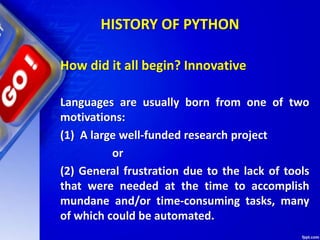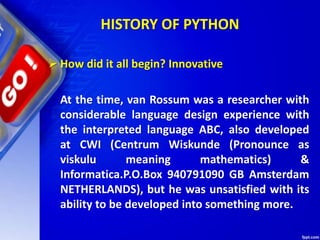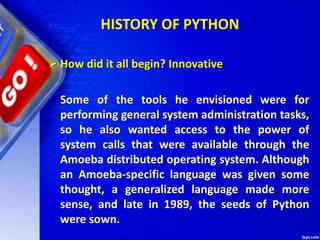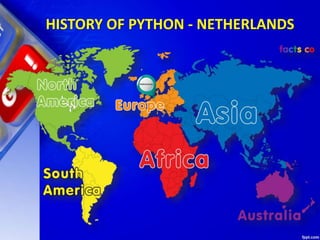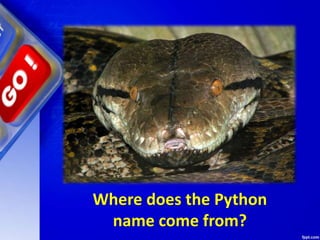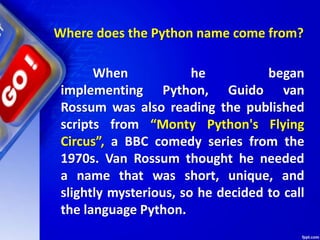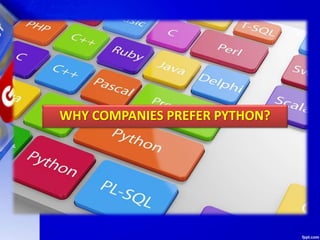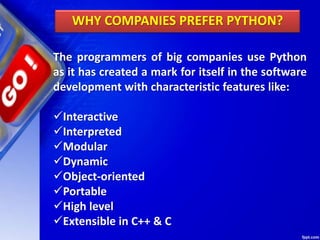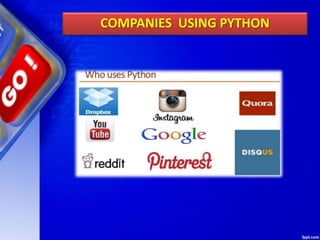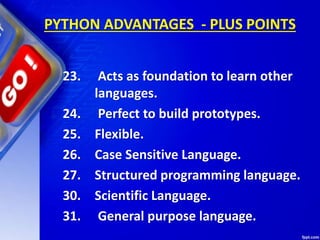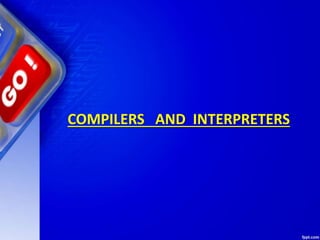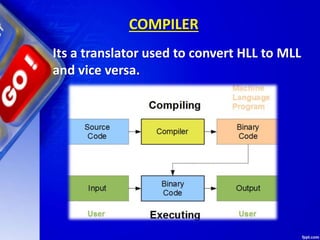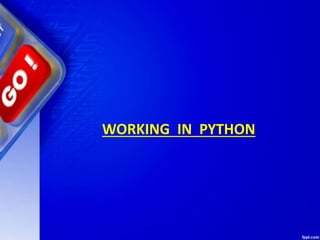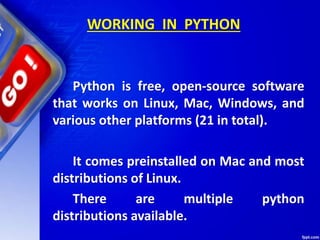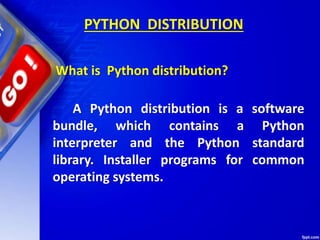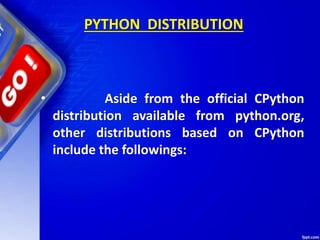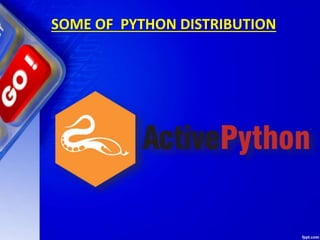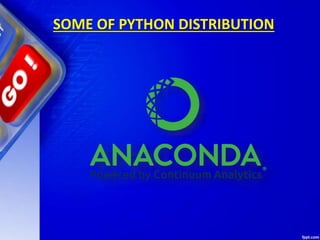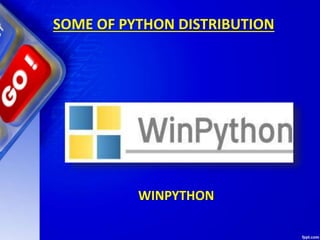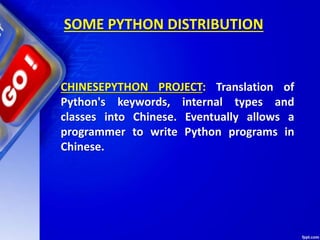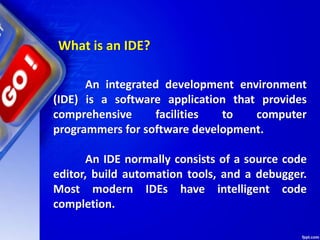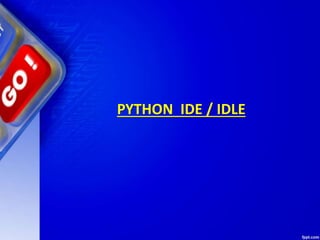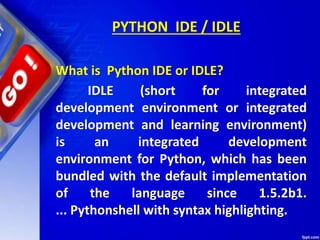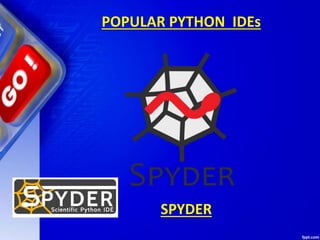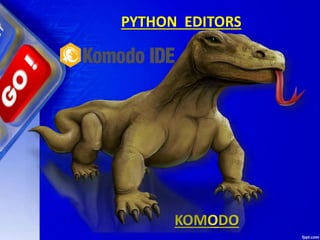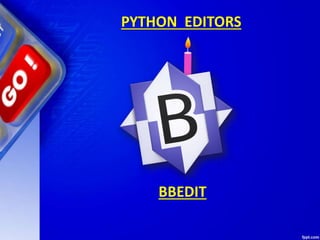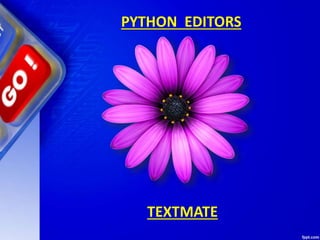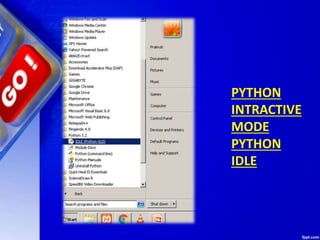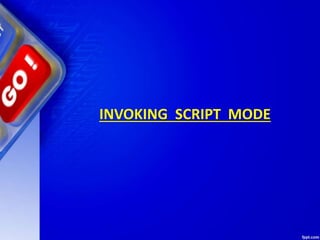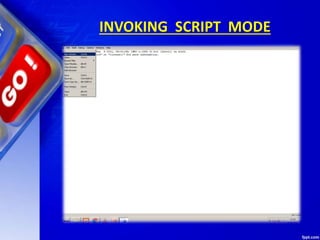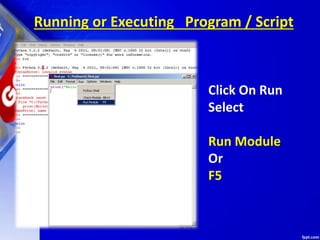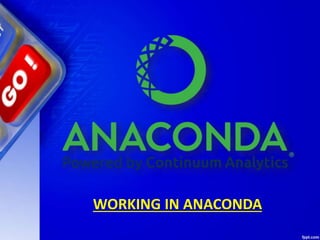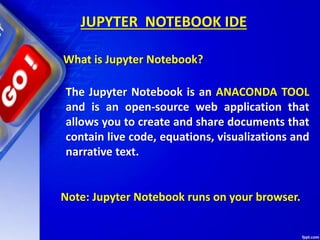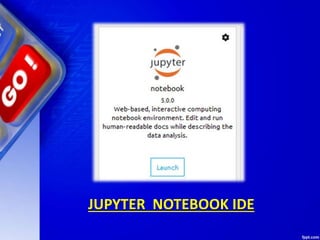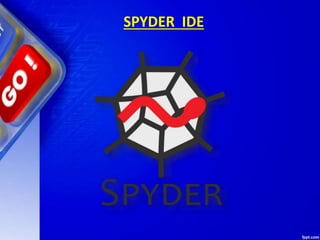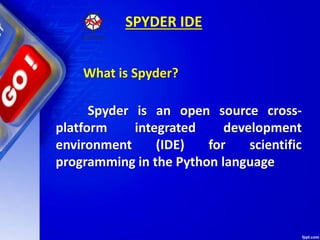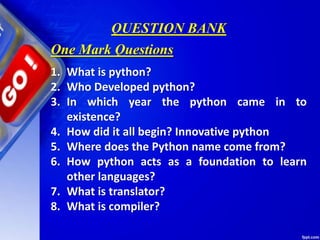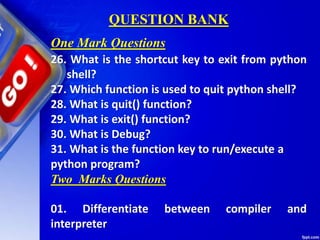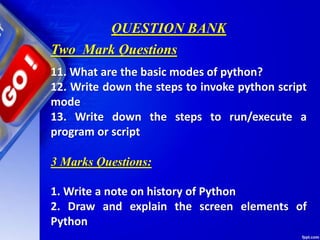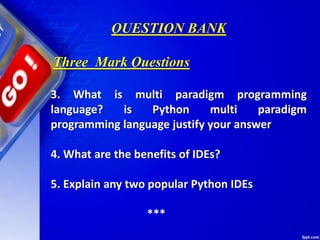Chapter 5 Getting Started with Python.pptx
- 1. CHAPTER 07 GETTING STARTED WITH PYTHON
- 2. Unit 2: XI Computer Science (083) Board : CBSE Courtesy CBSE Computational Thinking and Programming
- 3. CHAPTER 1 GETTING STARTED WITH PYTHON
- 4. INTRODUCTION Python is a high-level, interpreted and general- purpose dynamic programming language that focuses on code readability. The syntax in Python helps the programmers to do coding in fewer steps as compared to Java or C++. The language founded in the year 1991 by the developer Guido Van Rossum has the programming easy and fun to do.
- 8. GUIDO VAN ROSSUM Guido van Rossum is a Dutch programmer best known as the author of the Python programming language, for which he was the "Benevolent Dictator For Life" until he stepped down from the position in July 2018.
- 9. GUIDO VAN ROSSUM Born 31 January 1956 (age 62) Haarlem, Netherlands Residence Belmont, California, U.S. Nationality Dutch Alma mater University of Amsterdam Occupation Computer programmer, author Employer Dropbox Known for Creating the Python programming language Spouse(s) Kim Knapp (m. 2000) Children Orlijn Michiel Knapp-van Rossum Website www.python.org/~guido/
- 10. INTRODUCTION The Python is widely used in bigger organizations because of its multiple programming paradigms. They usually involve imperative and object-oriented functional programming. It has a comprehensive and large standard library that has automatic memory management and dynamic features.
- 11. INTRODUCTION Python is a general-purpose language, which means it can be used to build just about anything, which will be made easy with the right tools/libraries. Professionally, Python is great for backend web development, data analysis, artificial intelligence, and scientific computing. Many developers have also used Python to build productivity tools, games, and desktop apps, so there are plenty of resources to help you learn how to do those as well.
- 12. HISTORY OF PYTHON Work on Python began in late 1989 by Guido van Rossum, then at Centrum Wiskunde (Pronounce as viskulu meaning mathematics) & Informatica CWI in the Netherlands, and eventually released for public distribution in early 1991.
- 13. HISTORY OF PYTHON Python was conceived in the late 1980s, and its implementation began in December 1989 by Guido van Rossum at Centrum Wiskunde (Pronounce as viskulu meaning mathematics) & Informatica (CWI) in the Netherlands as a successor to the ABC language (itself inspired by SETL) capable of exception handling and interfacing with the Amoeba operating system. Where was Python created?
- 14. HISTORY OF PYTHON Since most modern OS are written in C, compilers/interpreters for modern high-level languages are also written in C. Python is not an exception - its most popular/"traditional" implementation is called CPython and is written in C. There are other implementations: IronPython (Python running on .NET). What language is Python written in?
- 15. HISTORY OF PYTHON How did it all begin? Innovative Languages are usually born from one of two motivations: (1) A large well-funded research project or (2) General frustration due to the lack of tools that were needed at the time to accomplish mundane and/or time-consuming tasks, many of which could be automated.
- 16. HISTORY OF PYTHON How did it all begin? Innovative At the time, van Rossum was a researcher with considerable language design experience with the interpreted language ABC, also developed at CWI (Centrum Wiskunde (Pronounce as viskulu meaning mathematics) & Informatica.P.O.Box 940791090 GB Amsterdam NETHERLANDS), but he was unsatisfied with its ability to be developed into something more.
- 17. HISTORY OF PYTHON How did it all begin? Innovative Some of the tools he envisioned were for performing general system administration tasks, so he also wanted access to the power of system calls that were available through the Amoeba distributed operating system. Although an Amoeba-specific language was given some thought, a generalized language made more sense, and late in 1989, the seeds of Python were sown.
- 18. HISTORY OF PYTHON What is CWI? Where it is located? Centrum Wiskunde (Pronounce as viskulu meaning mathematics) & Informatica (CWI) is the national research institute for mathematics and computer science in the Netherlands. Founded in 1946, CWI is part of the Institutes Organisation of NWO, NWO-I. While located at Amsterdam Science Park, this institute has strong international links, and enjoy a global reputation for innovative research.
- 19. HISTORY OF PYTHON - NETHERLANDS
- 20. HISTORY OF PYTHON - NETHERLANDS
- 21. HISTORY OF PYTHON – CWI GOOGLE MAP
- 22. Where does the Python name come from?
- 23. When he began implementing Python, Guido van Rossum was also reading the published scripts from “Monty Python's Flying Circus”, a BBC comedy series from the 1970s. Van Rossum thought he needed a name that was short, unique, and slightly mysterious, so he decided to call the language Python. Where does the Python name come from?
- 24. WHY COMPANIES PREFER PYTHON?
- 25. Python has top the charts in the recent years over other programming languages like C, C++ and Java and is widely used by the programmers. The language has undergone a drastic change since its release 25 years ago as many add-on features are introduced. The Python 1.0 had the module system of Modula-3 and interacted with Amoeba Operating System with varied functioning tools. Python 2.0 introduced in the year 2000 had features of garbage collector and Unicode Support. WHY COMPANIES PREFER PYTHON?
- 26. Python 3.0 introduced in the year 2008 had a constructive design that avoids duplicate modules and constructs. With the added features, now the companies are using Python 3.5. The software development companies prefer Python language because of its versatile features and fewer programming codes. Nearly 14% of the programmers use it on the operating systems like UNIX, Linux, Windows and Mac OS. WHY COMPANIES PREFER PYTHON?
- 27. The programmers of big companies use Python as it has created a mark for itself in the software development with characteristic features like: Interactive Interpreted Modular Dynamic Object-oriented Portable High level Extensible in C++ & C WHY COMPANIES PREFER PYTHON?
- 28. The programmers of big companies use Python as it has created a mark for itself in the software development with characteristic features like: Easy-to-learn Easy-to-read Easy-to-maintain Robust Effective as a Rapid Prototyping Tool A Memory Manager Interpreted and (Byte-) Compiled WHY COMPANIES PREFER PYTHON?
- 34. PYTHON ADVANTAGES - PLUS POINTS
- 35. PYTHON ADVANTAGES - PLUS POINTS 01. Easy to Use. 02. Expressive Language. 03. Interpreted Language. 04. Its Completeness. 05. Cross Plat Form Language. 06. Free and Open Source. 07. Variety of Usage/Applications.
- 36. PYTHON ADVANTAGES - PLUS POINTS 08. Interactive. 09. Modular. 10. Dynamic. 11. Object-oriented. 12. Portable. 13. High level. 14. Extensible in C++ & C.
- 37. PYTHON ADVANTAGES - PLUS POINTS 15. Easy-to-learn . 16. Easy-to-read. 17. Easy-to-maintain. 18. Robust. 19. Effective as a Rapid Prototyping Tool 20. A Memory Manager. 21. Interpreted and (Byte-) Compiled. 22. Multi paradigm language.
- 38. PYTHON ADVANTAGES - PLUS POINTS 23. Acts as foundation to learn other languages. 24. Perfect to build prototypes. 25. Flexible. 26. Case Sensitive Language. 27. Structured programming language. 30. Scientific Language. 31. General purpose language.
- 40. PYTHON DISADVANTAGES - MINUS POINTS 01. Speed. 02. Mobile Development. 03. Easy-to-maintain. 04. Memory Consumption. 05. Database Access. 06. Runtime Errors. 07. Not Strong on Type-Binding or Dynamic Typing.
- 41. PYTHON DISADVANTAGES - MINUS POINTS 08. Python is evolving continuously. 09. Not a great choice for a high-graphic 3d game. 10. Designs issues. 11. Memory Consumption. 12. Simple rules.
- 43. COMPILER Its a translator used to convert HLL to MLL and vice versa.
- 44. COMPILER Its a translator used to convert HLL to MLL and vice versa.
- 45. INTERPRETER Its a translator used to convert HLL to MLL and vice versa.
- 46. INTERPRETER Its a translator used to convert HLL to MLL and vice versa.
- 48. WORKING IN PYTHON Python is free, open-source software that works on Linux, Mac, Windows, and various other platforms (21 in total). It comes preinstalled on Mac and most distributions of Linux. There are multiple python distributions available.
- 50. PYTHON DISTRIBUTION A Python distribution is a software bundle, which contains a Python interpreter and the Python standard library. Installer programs for common operating systems. What is Python distribution?
- 51. PYTHON DISTRIBUTION • Aside from the official CPython distribution available from python.org, other distributions based on CPython include the followings:
- 52. SOME OF PYTHON DISTRIBUTION
- 53. SOME OF PYTHON DISTRIBUTION
- 54. SOME OF PYTHON DISTRIBUTION ENTHOUGHT'S CANOPY
- 55. SOME OF PYTHON DISTRIBUTION WINPYTHON
- 56. SOME PYTHON DISTRIBUTION CHINESEPYTHON PROJECT: Translation of Python's keywords, internal types and classes into Chinese. Eventually allows a programmer to write Python programs in Chinese.
- 58. What is an IDE? An integrated development environment (IDE) is a software application that provides comprehensive facilities to computer programmers for software development. An IDE normally consists of a source code editor, build automation tools, and a debugger. Most modern IDEs have intelligent code completion.
- 59. PYTHON IDE / IDLE
- 60. PYTHON IDE / IDLE IDLE (short for integrated development environment or integrated development and learning environment) is an integrated development environment for Python, which has been bundled with the default implementation of the language since 1.5.2b1. ... Pythonshell with syntax highlighting. What is Python IDE or IDLE?
- 62. POPULAR PYTHON IDEs GitHub : NINJA IDE
- 68. POPULAR PYTHON IDEs CODERS’ DIARIES
- 80. PYTHON EDITORS
- 96. PYTHON SHELL What is Shell? A shell is usually an "interactive shell", usually termed a REPL which stands for "Read - Execute - Print - Loop" Most interpreted languages offer a REPL interface - whether its LISP, python, BASIC or Javascript or even DOS batch language or Unix Shells. The interpreter is what actually executes the lines of code.
- 97. PYTHON SHELL What is Python Shell or Python Interactive Shell? The Python interpreter can be used from an interactive shell. The interactive shell is also interactive in the way that it stands between the commands or actions and their execution. ... Python offers a comfortable command line interface with the Python shell, which is also known as the "Python interactive shell".
- 99. PYTHON BASIC MODES What are the basic modes of python? Python has two basic modes: 1) Script and 2) Interactive.
- 100. PYTHON BASIC MODES 1) Script Mode: The normal mode is the mode where the scripted and finished .py files are run in the Python interpreter.
- 101. PYTHON BASIC MODES 2) Interactive Mode: Interactive mode is a command line shell which gives immediate feedback for each statement, while running previously fed statements in active memory.
- 102. SCRIPT What is Script? Scripts are reusable. Basically, a script is a text file containing the statements that comprise a Python program. Once you have created the script, you can execute it over and over without having to retype it each time. Scripts are editable.
- 103. INVOKING SCRIPT MODE
- 104. INVOKING SCRIPT MODE
- 105. INVOKING SCRIPT MODE
- 106. Saving Script / Program File Click On File Select Save Give filename with py extension For Example: first.py Or first.PY
- 107. Running or Executing Program / Script Click On Run Select Run Module Or F5
- 108. WORKING IN ANACONDA
- 109. ANACONDA NAVIGATOR
- 110. JUPYTER NOTEBOOK IDE The Jupyter Notebook is an ANACONDA TOOL and is an open-source web application that allows you to create and share documents that contain live code, equations, visualizations and narrative text. Note: Jupyter Notebook runs on your browser. What is Jupyter Notebook?
- 111. JUPYTER NOTEBOOK IDE
- 112. JUPYTER NOTEBOOK IDE
- 113. JUPYTER DASHBOARD
- 115. JUPYTER SCRIPT MODE
- 116. SPYDER IDE
- 117. SPYDER IDE
- 118. SPYDER IDE Spyder is an open source cross- platform integrated development environment (IDE) for scientific programming in the Python language What is Spyder?
- 119. SPYDER IDE
- 120. PyScripter IDE
- 121. PyScripter IDE PyScripter is a free and open-source Python Integrated Development Environment (IDE) created with the ambition to become competitive in functionality with commercial Windows- based IDEs available for other languages What is PyScripter?
- 122. PyScripter IDE
- 123. Any Questions Please
- 124. Class Test
- 125. Class Test 1. What is python? 2. Who Developed python? 3. In which year the python came in to existence? 4. How did it all begin? Innovative python 5. Where does the Python name come from? 6. How python acts as a foundation to learn other languages? Two Marks each. ( 10 x 2 =20 )
- 126. Class Test 7. What is Python Shell or Python Interactive Shell? 8. What is Script mode? 9. What is Jupyter Notebook? 10. What is Spyder?
- 127. QUESTION BANK
- 128. QUESTION BANK 1. What is python? 2. Who Developed python? 3. In which year the python came in to existence? 4. How did it all begin? Innovative python 5. Where does the Python name come from? 6. How python acts as a foundation to learn other languages? 7. What is translator? 8. What is compiler? One Mark Questions
- 129. QUESTION BANK 09. What is interpreter? 10. What is an IDE? 11. What is Python IDE or IDLE? 12. What is an editor? 13. How editor is different from IDE? 14. List any four editors 15. What is shell? 16. What is Python Shell or Python Interactive Shell? 17. What is Script mode? One Mark Questions
- 130. QUESTION BANK 18. What is interactive mode? 19. What is the extension of python program/script? 20. What is the shortcut key to execute or run the script? 21. What is anaconda navigator? 22. What is Jupyter Notebook? 23. What is Spyder? 24. What is PyScripter? 25. Is python supports object oriented programming? One Mark Questions
- 131. QUESTION BANK 26. What is the shortcut key to exit from python shell? 27. Which function is used to quit python shell? 28. What is quit() function? 29. What is exit() function? 30. What is Debug? 31. What is the function key to run/execute a python program? Two Marks Questions 01. Differentiate between compiler and interpreter One Mark Questions
- 132. QUESTION BANK 02. Why companies prefer python? 03. List any 5 companies using python 04. What are the advantages of python 05. What are the disadvantages of python 06. What is Cross plat form language? 07. What is Python distribution? 08. List any four Python IDEs 09. Differentiate between Script mode and interactive mode 10. Write down the steps to invoke python software Two Mark Questions
- 133. QUESTION BANK 11. What are the basic modes of python? 12. Write down the steps to invoke python script mode 13. Write down the steps to run/execute a program or script 3 Marks Questions: 1. Write a note on history of Python 2. Draw and explain the screen elements of Python Two Mark Questions
- 134. QUESTION BANK 3. What is multi paradigm programming language? is Python multi paradigm programming language justify your answer 4. What are the benefits of IDEs? 5. Explain any two popular Python IDEs *** Three Mark Questions
- 135. Thank You













